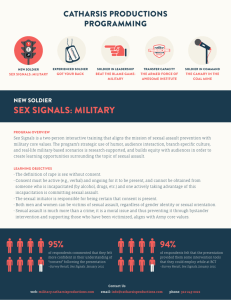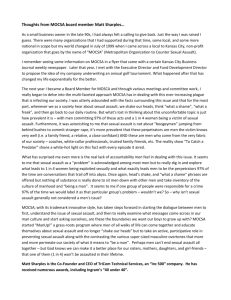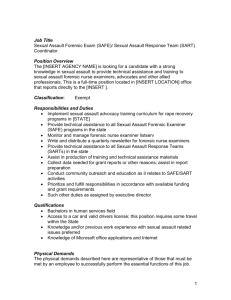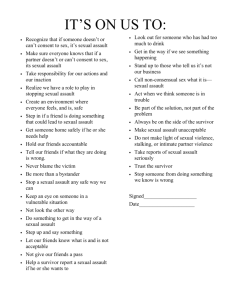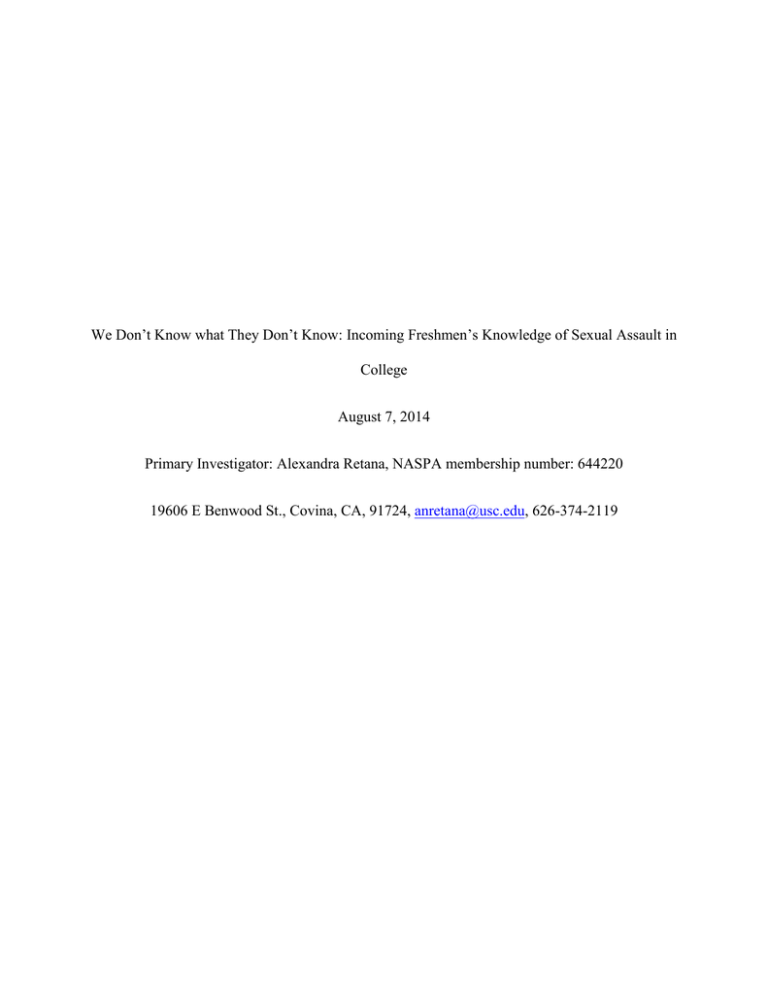
We Don’t Know what They Don’t Know: Incoming Freshmen’s Knowledge of Sexual Assault in
College
August 7, 2014
Primary Investigator: Alexandra Retana, NASPA membership number: 644220
19606 E Benwood St., Covina, CA, 91724, anretana@usc.edu, 626-374-2119
Introduction
One of the most prevalent topics in the world of higher education today is sexual assault
on college campuses across the United States. The victimization of women, reporting
procedures, sexual assault policies, the care and support for victims, the punishments for
perpetrators, investigatory procedures, and campus responses are all topics that are currently
being looked at closely by the media, parents, students, and administrators. It is essential for
college administrators to implement programs regarding sexual assault prevention and victim
support. Research has shown that college women are at an especially high risk for sexual assault
as estimates have shown that one in four women will be a victim of sexual assault during their
time in college (Turchik and Hassija, 2014). While there has been a push for reactionary
procedures, it is also essential for proactive measures to be established by administrators. The
writer of this grant submission is proposing a research study that will aid the University of
Southern California in being proactive about increasing its students’ knowledge of sexual assault
which would hopefully result in reducing the number of sexual assaults on campus and to
increase the percentages of students who report sexual assault occurrences. The study will
evaluate the general knowledge of the incoming classes at USC to determine their definitions of
sexual assault, the affects they believe it has on a person, and the scenarios they would consider
to be a form of sexual assault.
Purpose for Study
The purpose for this study is to determine the knowledge of incoming freshman at USC
surrounding sexual assault. For the purpose of this study, incoming freshman are defined as
students who have submitted their intent to enroll at USC, but have not yet arrived on campus for
welcome week activities and/or their first day of classes. More specifically the study aims to
uncover the ways in which incoming freshman define sexual assault, if they consider it an
important issue, if they know what to do if it should happen, the support they might desire on
campus, and if they are aware of the definition of coercion and if they can identify examples of
coercion. The study will also aim to determine if they have had any education regarding sexual
assault, what their definition of consent is, how drugs and alcohol affect situations regarding
sexual assault, and if they are aware of the statistics regarding sexual assault in college.
Rationale
The rationale for conducting this study is to address the issue of sexual assault at the
University of Sothern California. One reason for conducting this study is to better understand the
state of mind of the males and females in the incoming freshmen class as both sexes can become
victims and perpetrators of sexual assault. There are programs in place for victim support, but
there needs to be a more structured education for males as well, and this study would let
administrators know what needs or does not need to be included in that education. While
teaching women about the resources and options after sexual assault is useful, it is also essential
to teach males to not sexually assault their peers. The results of this study will aid educators in
determining how USC programs can be more proactive rather than reactive in reducing the
number of sexual assaults that occur on campus.
Relevance
Studies on college students’ knowledge about sexual assault are especially relevant to the
student affairs profession today. The push for a more transparent system and increased sexual
assault education has been catalyzed by the recent occurrences involving Pennsylvania State
University and the administration cover up of sexual assault allegations, and the federal
investigations of the alleged underreporting of sexual assault occurrences at both Occidental and
the University of Southern California.
Description of the Study
A review of the literature displayed many studies which result in quantitative results and
showed a lack of qualitative studies. In addition, the studies regarding sexual assault that have
been conducted involve samples including individuals at various levels of their undergraduate
careers. There is a gap in the literature when it comes to focusing on incoming freshman;
therefore, research results are based the actions and beliefs of students after they have
transitioned into the college environment. In addition, the research is presented in terms of the
researchers definitions and understanding of the topics surrounding sexual assault which means it
is possible that researchers and subjects have different definitions for similar terms. This is why
it is necessary to understand the sample’s definitions and understandings of terms and topics
regarding sexual assault especially before students arrive on campus. With that knowledge,
educators could develop programs to meet students at their level of knowledge.
In a qualitative study conducted by Lindgren and colleagues (2009), the differences in
sexual communication and expectations of men and women were identified. While the study
produced results about the sexual culture in college, the study and the discussions in focus
groups in that study included individuals in different levels of their undergraduate career. By this
time, men have been especially influenced by all-male groups, including fraternities, athletic
teams and all-male residence hall floors (Walgemuth, Barone, and Linder, 2007).This is an issue
as a factor of sexual assault is that it is “a learned behavior acquired through routine social and
environmental interaction . . . and an extreme form of the traditionally socialized ways that men
and women act in the context of sexual relations.” Programs established at the beginning of an
individual’s freshman year could aid in developing an awareness and defiance of rape culture,
rape myths, and stereotyping which contributes to sexual assault.
Studies have also shown that victims and perpetrators do not label sexual assaults as such
and therefore, continue to show an acceptance of behaviors even when these incidents align with
the technical definitions of sexual assault (Neidig, 2009). It is essential for administrators to
know the differences in what student affairs professionals consider sexual assault and what
students consider sexual assault. By surveying the incoming freshman body at USC about their
definitions and perceptions of sexual assault, administrators can address these differences at the
beginning of students’ college careers based on the students’ beliefs before they are influenced
by campus culture.
The method of this study is to gather the desired information from a survey that will be
administered online to the incoming freshman class at USC. The survey will be administered to
students after they have submitted their intent to enroll and before the arrive on campus for
welcome week in the fall. Students who are admitted as spring admits will take the survey at the
same time as the fall admits. The research team would work with Title IX coordinators, the USC
Center for Women and Men, USC Student Judicial Affairs and Community Standards to
formulate questions that will appear on the survey. The input of these offices is valuable as they
are the stakeholders in regards to the topic of sexual assault on campus. The research team will
ask the stakeholders what they might like to see on the survey so that they can do their job in
supporting students or if there have been effective questions they have used in the past. Once the
survey had been conducted it will be submitted to the Institutional Review Board if needed.
Once the survey is approved, it will be administered to USC incoming freshman. The
writer of this proposal has recently been in communication with the USC Orientation Office to
determine how the survey would reach the students before they move to campus. This would
occur online via email or during a student affairs information session during USC Orientation.
Because the survey will be voluntary, the incentive will be that completion of the survey equals
one entry into a raffle for two tickets to Disneyland in Anaheim, CA.
Given that the number of incoming freshman in fall of 2014 is approximately 2800
students according to USC’s freshman class profile, the number of students admitted in the Fall
of the subsequent year will be similar (USC Media, 2014). Due to the high volume of responses
expected, it would be feasible to bring on two other members to the research team to help with
data collection and analysis. Once we receive the results, the research team will analyze the data
to determine what the incoming freshman class at USC knows about sexual assault on college
campuses.
Contribution to the Field
This study’s innovation and contribution to the student affairs field lies in the survey’s
timing. While most discussions and studies regarding sexual assault occur only when there has
been an incident or when students have already transitioned into college life, the survey would
allow us to prepare and adapt our programs to incoming freshmen levels of knowledge about
sexual assault. Not only would we have a better understanding of the incoming class, but
administrators can prepare themselves to meet the students at their level and to address any
concerning issues. The survey alone may also allow students to recognize what they do not know
regarding the subject, and potentially develop some awareness. The survey results would assist
educators in forming effective programs similar to the alcohol education program USC students
are required to complete before they arrive on campus, or the education could take the form of a
seminar for freshman during the first weeks of the school year. The programs would aim help
men and women understand rape culture, sexual assault, growth of personal identity, and how to
prevent sexual assault from happening. If the survey proves to be especially effective, the model
will also be shared with NASPA and other professional organizations so that they may apply it to
their populations.
NASPA statement of Understanding
I agree to the acknowledgement of the NASPA Foundation funding support in all phases
of the research project. I agree to permit the Foundation and NASPA to post the awarding of the
grant with a summary of the project and the list of the primary investigator and the project team
on the appropriate web pages. I agree not to use any part or portion of the project for commercial
purposes. I agree to provide the Foundation with a complete summary of the project and the
findings within six months of completion of the project. The results will be posted on the
foundation and NASPA web pages for general dissemination. I agree to provide the Foundation
with a detailed account of how the funds were expended no later than twenty four months after
the receipt of the grant funds. I agree to submit the results of the research to a NASPA related
journal in the form of a referred article and or for a presentation of the findings at the NASPA
national conference. Currently, the journals include: the Journal of Student Affairs Theory and
Practice, the Journal of Women in Higher Education and the Journal of College and Character.
Estimated Budget
The budget for this project includes stipends for graduate assistants, the annual
subscription fee to Survey Monkey survey and data collection software, and the incentives for
participating in the survey. Because we expect a high volume of surveys completed, two
graduate assistants who have completed a research methods course will be recruited to assist
with data collection, data entry, coding, and data analysis. This eliminates the need to outsource
our data while providing graduate students with an opportunity to engage in data collection and
analysis. This will also allow the research team to be sure that our interpretations and coding of
the students’ responses are consistent. To send out the survey and collect data, an annual
subscription to survey monkey is necessary. Because the survey is voluntary, the incentive for
student participation is two admission tickets to Disneyland in Anaheim, CA. The theme park is
close in proximity to USC and a popular tourist cite in Southern California.
Budget Item
Amount
Sub-total
Graduate Research Assistant 1
$1500
Graduate Research Assistant 2
$1500
$3000
Survey Monkey annual subscription
$780
$780
Admission Tickets to Disneyland
$96
Admission Tickets to Disneyland
$96
$192
Total
$3972
References
Lindgren, K. P., Schacht, R. L., Pantalone, D. W., Blayney, J. A., & George, W. H. (2009).
Sexual communication, sexual goals, and students’ transition to college: Implications for
sexual assault, decision-making, and risky behaviors. Journal of College Student
Development, 50(5), 491-503. doi:10.1353/csd.0.0095
Neidig, J. (2009). Sex, booze, and clarity: Defining sexual assault on a college campus. William
& Mary Journal of Women and the Law, 16(1), 179.
Turchik, J. A., & Hassija, C. M. (2014). Female sexual victimization among college students:
Assault severity, health risk behaviors, and sexual functioning. Journal of Interpersonal
Violence, 29(13), 2439-2457. doi:10.1177/0886260513520230
USC Media Relations (2014). USC releases admissions statistics for fall 2014. Press room: A
resource for Journalists. Retrieved from https://pressroom.usc.edu/usc-releasesadmission-statistics-for-fall-2014/
Wolgemuth, J. R., Linder, C., & Barone, R. P. (2007). Preventing sexual assault through
engaging college men. Journal of College Student Development, 48(5), 585-594.
doi:10.1353/csd.2007.0045

